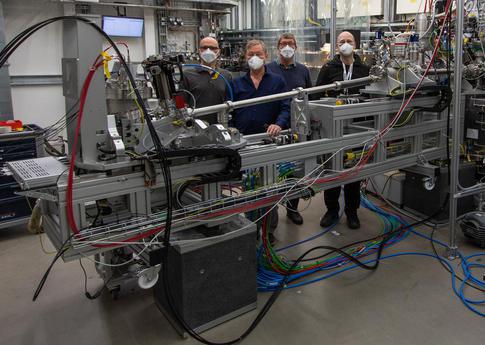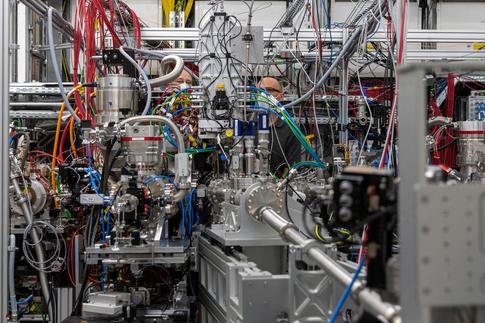XFEL: New spectrometer for extreme UV and soft X-ray light enables novel research
New spectrometer for extreme UV and soft X-ray light enables novel research

Researchers from European XFEL and Uppsala University standing behind the new 1D-imaging XUV spectrometer at SQS. Left to right: T. Baumann (EuXFEL), J.-E. Rubensson (U. Uppsala), M. Meyer (EuXFEL), and M. Agåkar (U. Uppsala).
“The spectrometer will give us the ability to look at XUV light emitted from atoms and molecules. Its unique capability to image along the interaction zone enables us to study the effect of European XFEL’s intense X-ray radiation as it travels through dense gases,” says Michael Meyer, leading scientist of the SQS instrument. “It will offer new possibilities to study fundamental processes in the interaction of x-ray radiation with matter.”
Radiation with wavelengths in the extreme ultraviolet (XUV) range is emitted upon excitation or ionization of a sample by the European XFEL pulses. Spectroscopy of these emitted XUV photons is an ideal tool for studying the quantum mechanical properties of the sample in its interaction with the intense X-ray pulses. This is particularly useful in comparison with other techniques based on electron or ion spectroscopy as the photons are not severely impacted by the charged particles created during the interaction.
“At SQS we study fundamental properties of atomic and molecular systems, predominantly looking at electrons and ions. The new spectrometer complements these techniques and helps us to better understand physics on the very small scale,” says Thomas Baumann, scientist at SQS.

The new XUV spectrometer at the SQS instrument station.
The spectrometer was developed in Sweden as an in-kind contribution to European XFEL. “It is a great pleasure to finally see the instrument in operation,” says Jan-Erik Rubensson, Professor at the University of Uppsala and project leader. “We are eager to use the spectrometer and to explore together with our colleagues the new exciting capabilities.”
Find out more about the SQS instrument at: https://www.xfel.eu/facility/instruments/sqs/index_eng.html
Science contact:
Michael Meyer
Tel: +49-40-8998-5614
E-mail: michael.meyer@xfel.eu
Press contact:
Bernd Ebeling
Tel: +49-40-8998-6921
E-mail: pr@xfel.eu
